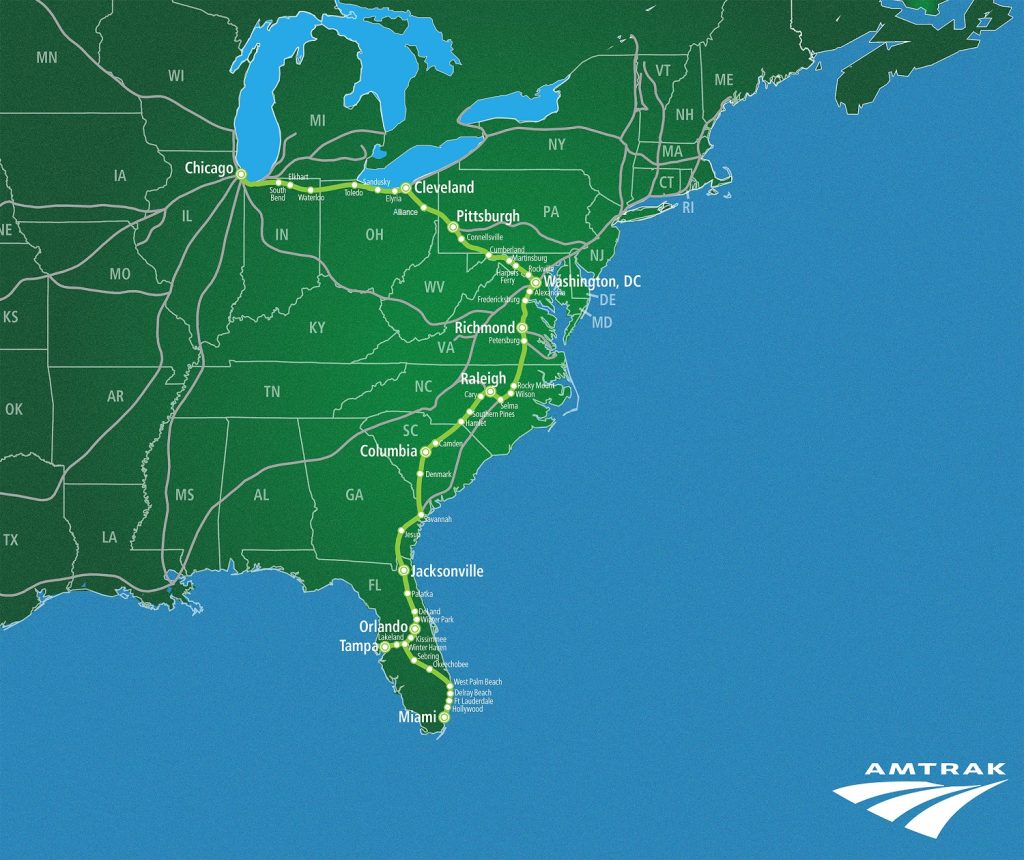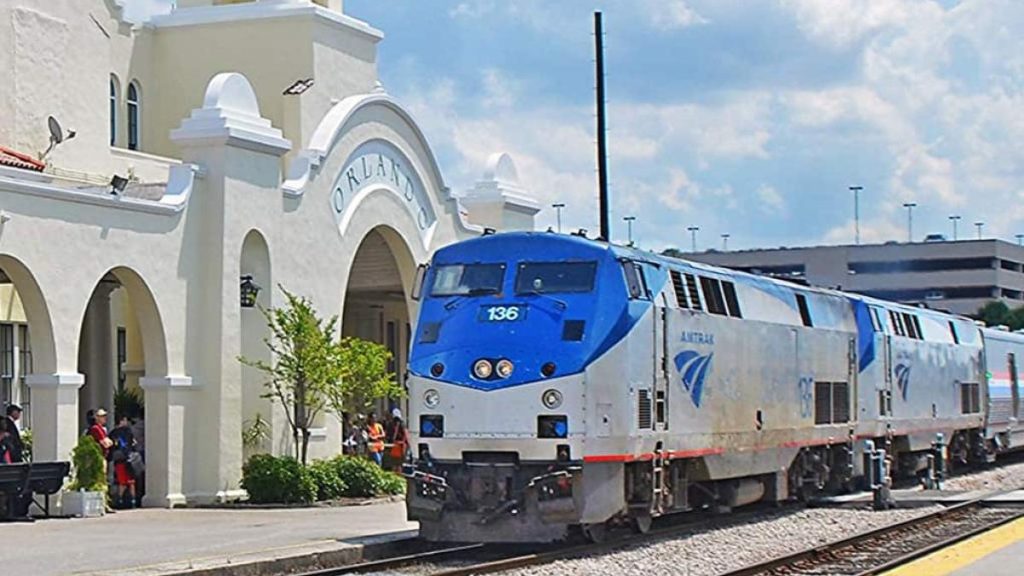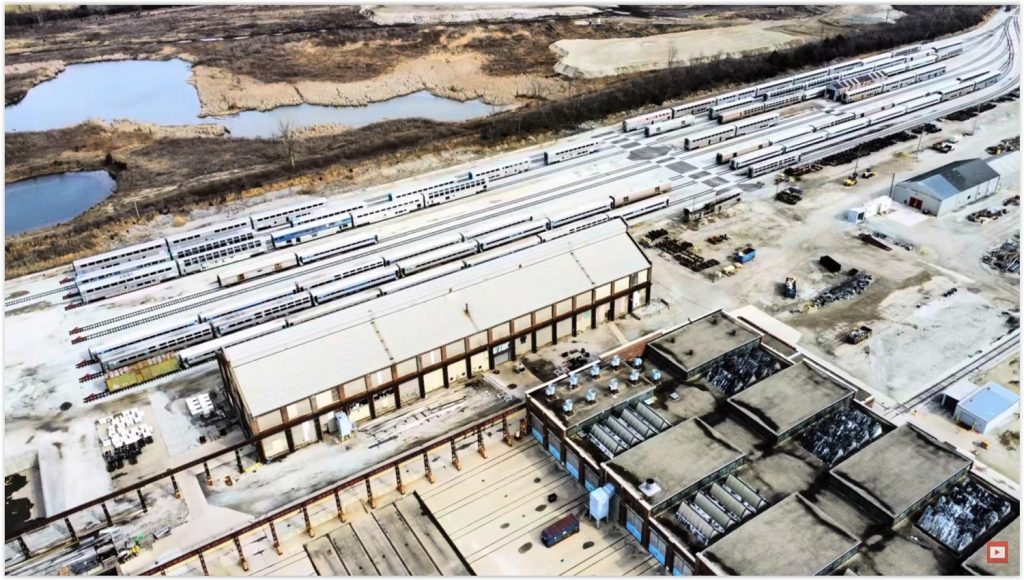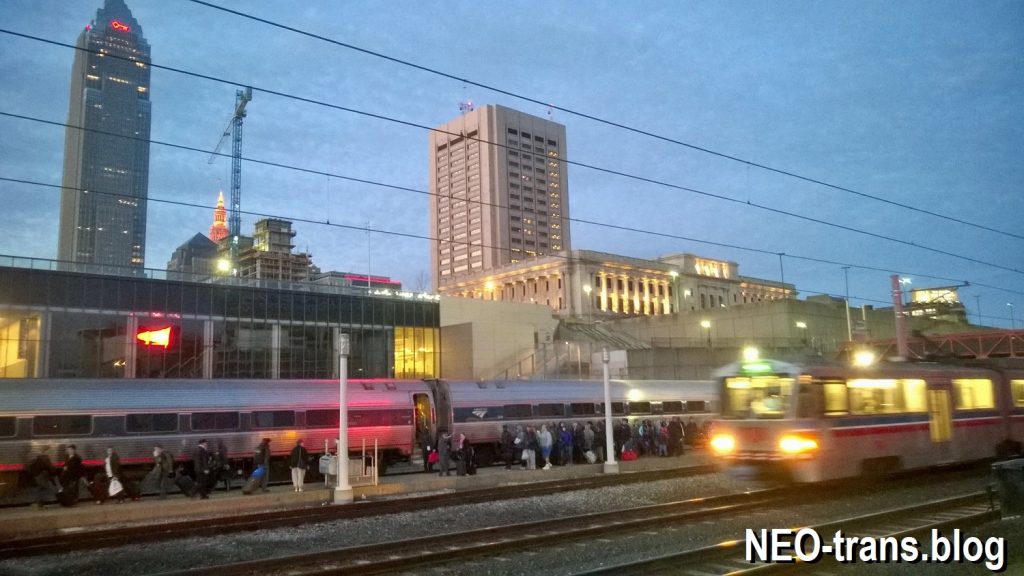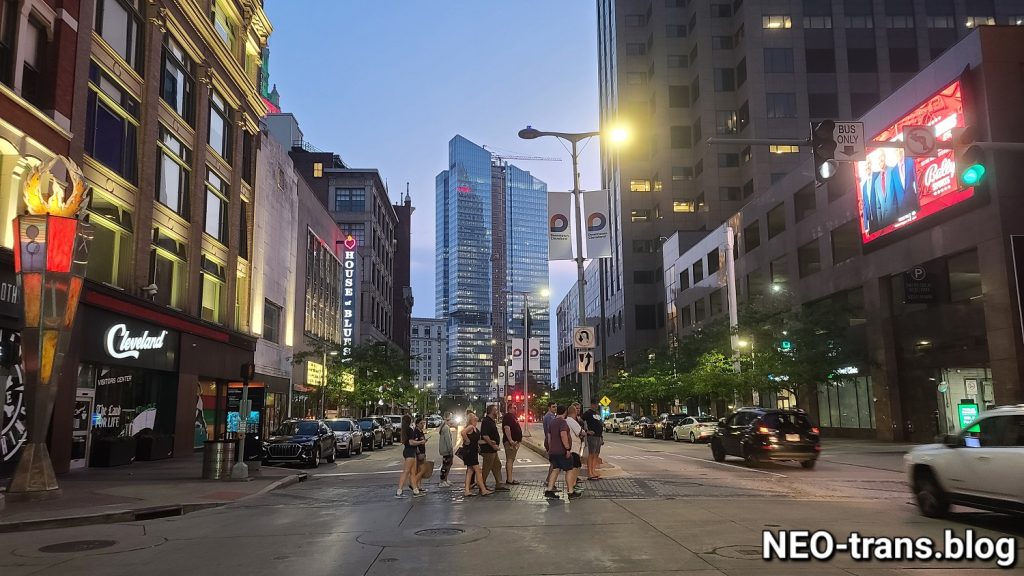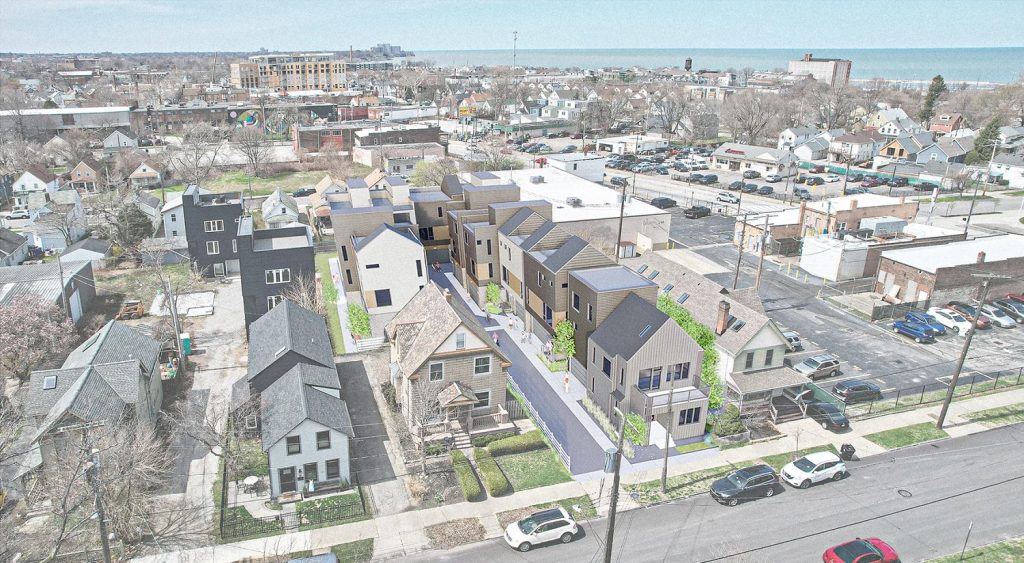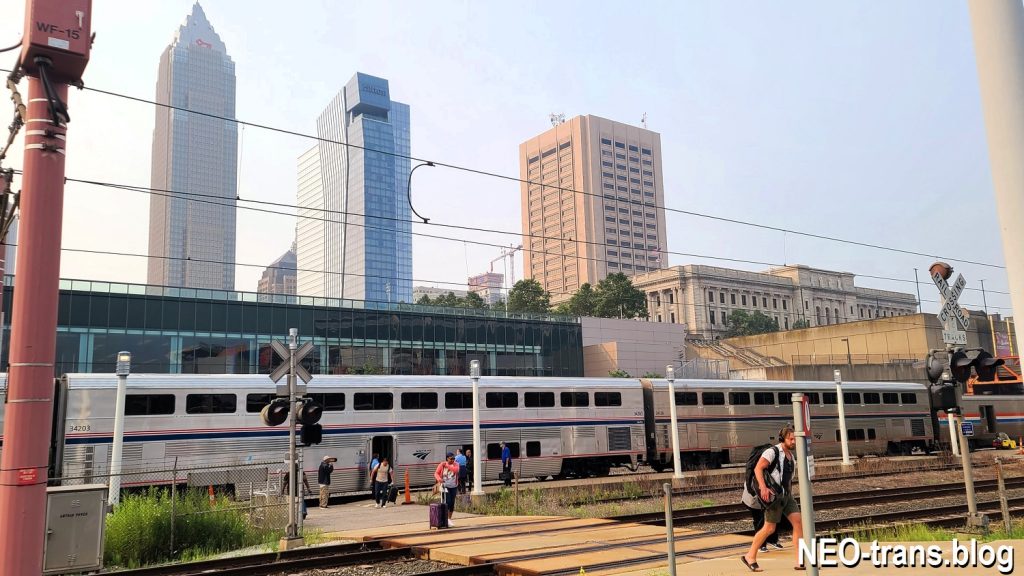
Amtrak has a shortage of these bilevel train cars on its western long-distance trains because it cut maintenance staff during the pandemic, Amtrak hasn’t fully reinstated them and has dozens of cars awaiting overhauls and other routine work. So Amtrak is taking the bilevel cars from its Chicago-Cleveland-Washington DC service, seen here, to keep its western trains running. Normally, Amtrak visits Cleveland in the pre-dawn hours except when trains are very late, as was the case here on July 17, 2023 (KJP). CLICK IMAGES TO ENLARGE THEM.
Amtrak cannibalizes trains to keep others running

While Amtrak’s press release about the creation of a direct-but-temporary Chicago-Florida passenger rail service through Cleveland touted it as an achievement, the reality behind it is actually quite different. According to several sources, the direct service is being implemented to rescue Amtrak from its own shortcomings — both internal and external.
Beginning Nov. 10, Amtrak is temporarily combining two of its train services into one called The Floridian. One is the Chicago – Cleveland – Washington DC Capitol Limited. The other is the New York City – Washington DC – Miami Silver Star. Each service has one train in each direction daily and serves many big and small cities along the way. The Silver Star makes 35 en route station stops; the Capitol Limited 14.
Amtrak says the reason for the combination is because the national passenger railroad company is making $1.6 billion worth of repairs to its tunnels in New York City under the East River. Those tunnels link Pennsylvania Station in Manhattan with its train storage yards and servicing facilities in Sunnyside, Queens.
Rail traffic capacity through the four-track tunnels will be limited during the three-year reconstruction project so the Silver Star’s trains will instead be sent to Chicago which also has a large Amtrak train servicing facility. There are 70 Amtrak trains on most days, traveling at speeds up to 150 mph between New York and Washington DC where Silver Star passengers can make their Northeast connections.
But that’s not the only reason why Amtrak was prompted to combine the two services. The other reason is something you don’t put in a press release.
“There’s two things at work here,” said James Tilley, co-chair of The Aurora Group, a nationwide nonprofit rail advocacy group and president of the Florida Coalition of Rail Passengers. He lives in Jacksonville which is served by the Silver Star. One issue is the New York City tunnel repairs, he agreed. “The other is a pressure point resulting from a shortage of bilevel cars (called Superliners) in the west,” Tilley said.
He cited internal Amtrak maintenance data that, as recently as last month, Amtrak had only 366 Superliners available for service nationwide. In 2018 Amtrak’s Corporate Planning Department reported that the bare minimum number of Superliners required to support its National System operating plan was 387 cars.
“Right off the bat, there is a 21-car shortage from the minimum,” Tilley said. “There may be cars in this total of 366 which have been cannibalized for parts as the (Office of Amtrak’s) Inspector General pointed out early this year suggesting an even lower serviceable count.”
Tilley also noted that Amtrak’s Capitol Limited uses three trains of five cars each or 15 Superliner cars total per day, potentially bringing the total number of available Superliners back up to as many as 381 cars. “That’s still lower than the minimum number of Superliners. It’s not going to be enough.”
Worse, the shortage is largely of Amtrak’s own making. A Sept. 1 Trains News Wire article acknowledged Amtrak was the victim of several derailments of trains that sidetracked 37 Superliner cars in the past four years. But Amtrak reportedly made little effort to restore those cars to service. In fact, Amtrak laid off train maintenance workers after the pandemic at its major repair facility in Beech Grove, IN and hasn’t hired most of them back.
“Building up the mechanical force is something we have been doing,” said Amtrak CEO Stephen Gardner at a Congressional hearing last year when he was grilled by Rep. Andre Carson (D-7, Indianapolis) about downsizing or outsourcing Amtrak train maintenance. “There is lots of work underway and it is a critical facility for Amtrak … because we’ve got to get our equipment back in shape and keep it maintained.”
Amtrak has had to cancel some trains, sometimes only a few hours before their scheduled departures, because they lacked enough Superliners. Although it was because inbound trains were very late, there were no reserve cars available to stand in. And when a Superliner car is found to be unsuitable for service and has to be removed from a train, there is often no substitute available — leaving some travelers stranded at the station or limited food/beverage service sold by a crew member in a coach seat.
Gardner did not dispute receiving substantial executive bonuses — $766,000 from 2016 to 2021 — despite that the company is unprofitable and sustained by taxpayers. He declined to say in that Congressional hearing what goals and metrics, such as reduced maintenance expenses, would trigger the bonuses.
Amtrak has pursued federal grants and loans to pay for restoring and buying new trains for 29 routes sponsored by 17 states. The Northeast Corridor is kept intact with tens of billions of dollars in federal funds in recent years with another $176 billion needed over the next 15 years to keep its trains running.
But Amtrak has made little or no effort to secure funding for rebuilding or replacing the aging Superliners out west or the single-level trains common on eastern long-distance routes, which are also in short supply. All of Ohio’s five nightly Amtrak trains are long-distance routes of 750 miles or more; all are between Chicago and the East Coast.
“Amtrak steals from peter to pay paul,” Tilley said. “They strip equipment from one train to keep another one operating.”
While ridership on Amtrak’s high-speed Acela trains in the Northeast hasn’t recovered from the pandemic, long-distance trains are regularly sold out. Part of the reason is because the trains are shorter due to having fewer cars available so ridership has dropped there, too. But the Floridian will be a longer train with more seats and bedrooms than the Capitol Limited, which should help address its sold-out conditions.
Still, the Silver Star of today is a smaller train compared pre-pandemic years, Tilley said. In 2023 versus 2022, passenger boardings on the Silver Star and Capitol Limited were down 20 percent and 25 percent, respectively, because of the shorter trains. To compensate, Amtrak raised ticket prices 30 percent on long-distance trains since the pandemic.
For example, the Cleveland-Orlando round trip on Amtrak during the first week of December costs $178 per person in coach or $1,917 for the cheapest bedroom accommodation for two people, Amtrak’s Web site shows. Flying CLE-ORL that same week costs as little as $98 round trip per person on Frontier or as much as $528 on United, according to an Internet search.
The Floridian will serve Cleveland’s lakefront station, 200 Memorial Shoreway, at the same nocturnal times as had the Capitol Limited — about 2 a.m. eastbound and 3 a.m. westbound. That’s if it’s on time. While the Capitol Limited was on time 70 percent throughout 2023, it’s being combined with the Silver Star which was on time only 49 percent, according to Amtrak data.
“Other than a one-seat ride to Florida, it’s still the same train in the middle of the night for us,” said Cleveland-area resident Ed D’Amato and a spokesman for the Lakeshore Rail Alliance. It is comprised of eight nonprofit advocacy organizations between Chicago and the East Coast. “The equipment shortage is definitely a reason for this (combined) train. The pandemic was the perfect time to work on rebuilding rail cars to get them back into service.”
Traveling from Cleveland to Orlando means spending 32 hours on the train — twice as long as driving and 10 times longer than flying. It’s even longer to travel beyond Tampa where the train makes a back-up move to head to South Florida, including West Palm Beach, Fort Lauderdale and Miami.
Ironically, if someone wants to arrive South Florida faster by train, they can get off Amtrak at Orlando, take a taxi to the Brightline train station at Orlando International Airport, and be in West Palm Beach, Fort Lauderdale or Miami at least 90 minutes faster. Brightline offers 16 trains in each direction between Orlando and Miami at speeds up to 125 mph.
END


